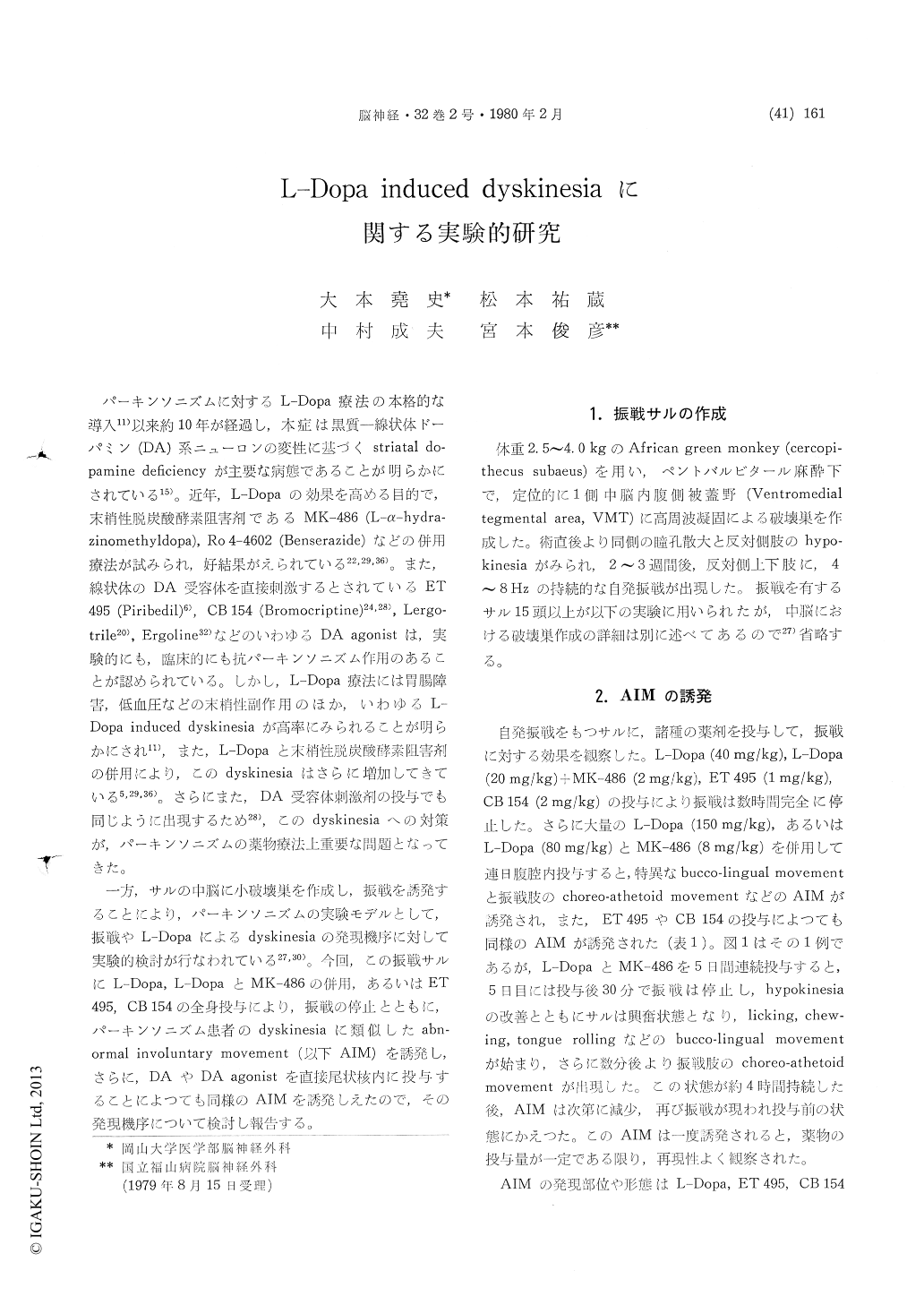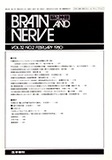Japanese
English
- 有料閲覧
- Abstract 文献概要
- 1ページ目 Look Inside
パーキンソニズムに対するL-Dopa療法の本格的な導入11)以来約10年が経過し,本症は黒質—線状体ドーパミン(DA)系ニューロンの変性に基づくstriatal do—pamine deficiencyが主要な病態であることが明らかにされている15)。近年,L-Dopaの効果を高める目的で,末梢性脱炭酸酵素阻害剤であるMK−486(L—α—hydra—zinomethyldopa),Ro4-4602(Benserazide)などの併用療法が試みられ,好結果がえられている22,29,36)。また,線状体のDA受容体を直接刺激するとされているET495(Piribedil)6),CB154(Bromocriptine)24,28),Lergo—trile20),Ergoline32)などのいわゆるDAagonistは実験的にも,臨床的にも抗パーキンソニズム作用のあることが認められている。しかし,L-Dopa療法には胃腸障害,低血圧などの末梢性副作用のほか,いわゆるL—Dopa induced dyskinesiaが高率にみられることが明らかにされ11),また,L-Dopaと末梢性脱炭酸酵素阻害剤の併用により,このdyskinesiaはさらに増加してきている5,29,36)。さらにまた,DA受容体刺激剤の投与でも同じように出現するため28),このdyskinesiaへの対策が,パーキンソニズムの薬物療法上重要な問題となってきた。
一方,サルの中脳に小破壊巣を作成し,振戦を誘発することにより,パーキンソニズムの実験モデルとして,振戦やL-Dopaによるdyskinesiaの発現機序に対して実験的検討が行なわれている27,30)。
Radiofrequency lesions were produced in the un-ilateral ventromedial tegmental area (VMT) ofafrican green monkeys (Cercopithecus subaeus). Subsequently resting tremor with 4-8 Hz frequency developed on the contralateral extremities. Re-petitive intraperitoneal injection of high dosage of L-dopa (150 mg/kg) for several days, or of L-dopa (80 mg/kg) combined with MK-486 (peripheral de-carboxylase inhibitor, 8 mg/kg) abolished the tremor, and followingly produced abnormal involuntary movements (dyskinesias). They were choreoathetoid in type and seen on the bucco-lingual region be-sides the extremities on the same side of tremor. These abnormal movements were very similar to those induced by L-dopa often observed in Parkin-sonian patients.
Administration of ET-495 (2mg/kg) and CB-154 (6 mg/kg) which are known as dopamine receptor stimulating agents, relieved the tremor and also induced dyskinesias which were same as those in-duced by L-dopa.
In order to investigate further pharmacological action of these drugs, various centrally acting drugs and enzyme inhibitors of catecholamine metabolism were studied in these monkeys. Alphamethyl-para-tyrosine (tyrosine hydroxylase inhibitor) and halo-peridol (dopamine receptor blocker) suppressed these dyskinesias. On the other hand, fusaric acid, L-5- HTP, DL-para-chlorophenylalanine and atropine had no effects on them. From these results, dyskinesias induced by L-Dopa seemed to be due to a direct stimulation of dopamine receptors by excessive ac-cumulation of dopamine in the striatum.
Another radiofrequency lesion was made in the ventrolateral nucleus of the thalamus ipsilateral to the VMT lesion. Soon after the operation, the tremor disappeared completely. Moreover, no dy-skinesia was produced even after the administration of very high dosage of L-dopa.
For injection of centrally acting drugs into the caudate nucleus, chronic cannulas were implanted in the head of the nucleus bilaterally in the monkeys with the tremor produced by VMT lesions. Each drug was solved in 10 id saline, and was injected through these cannulas. Either dopamine (300,μg), apomorphine (300μg) or ET-495 (300,μg) injected on the lesion side induced similar choreo-athetoid movements on both bucco-lingual region and con-tralateral extremities. These dyskinesias were the most prominent following an injection into the dorsomedial part of the caudate nucleus. While, injections into the normal side induced only bucco-lingual movements. No dyskinesia developed with intracaudate injections of other centrally acting drugs such as haloperidol, 5-HT, atropine and GABA. On the other hand, injections of haloperidol and clozapine suppressed dyskinesias produced by in-tramuscular administration of ET-495.
These results suggested that denervation super-sensitivity at the postsynaptic receptors was a basic condition to induce dyskinesias by L-dopa, and the caudate nuleus was not uniform pharmacologically.

Copyright © 1980, Igaku-Shoin Ltd. All rights reserved.


